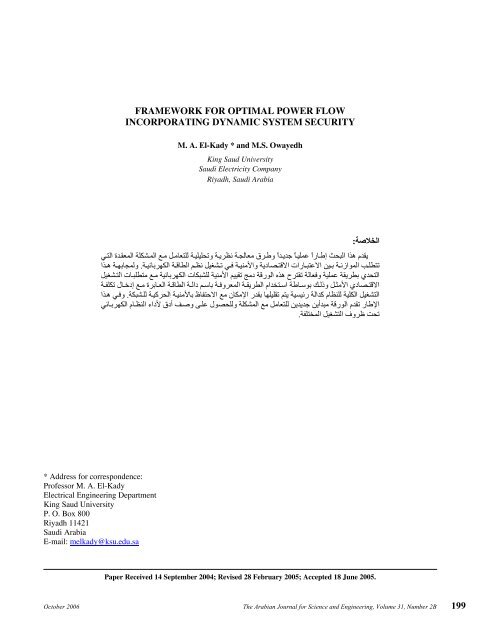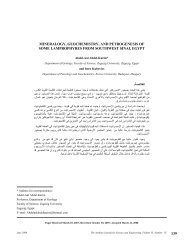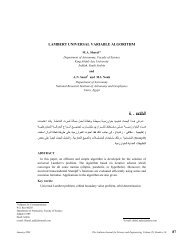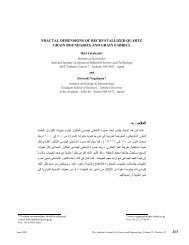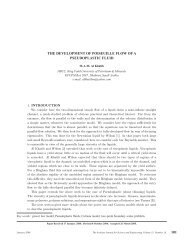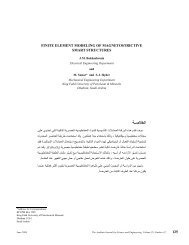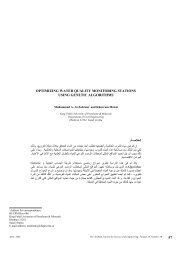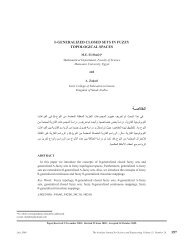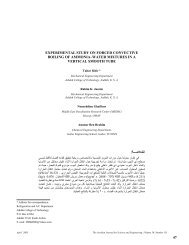199 framework for optimal power flow incorporating dynamic system ...
199 framework for optimal power flow incorporating dynamic system ...
199 framework for optimal power flow incorporating dynamic system ...
Create successful ePaper yourself
Turn your PDF publications into a flip-book with our unique Google optimized e-Paper software.
FRAMEWORK FOR OPTIMAL POWER FLOW<br />
INCORPORATING DYNAMIC SYSTEM SECURITY<br />
M. A. El-Kady * and M.S. Owayedh<br />
King Saud University<br />
Saudi Electricity Company<br />
Riyadh, Saudi Arabia<br />
M. A. El-Kady and M. S. Owayedh<br />
: ﺔﺻﻼﺨﻟا<br />
ﻲﺘﻟا ةﺪﻘﻌﻤﻟا ﺔﻠﻜﺸﻤﻟا ﻊﻣ ﻞﻣﺎﻌﺘﻠﻟ<br />
ﺔﻴﻠﻴﻠﺤﺗو ﺔﻳﺮﻈﻧ ﺔﺠﻟﺎﻌﻣ قﺮﻃو ًاﺪﻳﺪﺟ<br />
ًﺎﻴﻠﻤﻋ<br />
ًارﺎﻃإ<br />
ﺚﺤﺒﻟا اﺬه مﺪﻘﻳ<br />
اﺬه ﺔﻬﺑﺎﺠﻤﻟو . ﺔﻴﺋﺎﺑﺮﻬﻜﻟا ﺔﻗﺎﻄﻟا ﻢﻈﻧ ﻞﻴﻐﺸﺗ ﻲﻓ ﺔﻴﻨﻣﻷاو ﺔﻳدﺎﺼﺘﻗﻻا تارﺎﺒﺘﻋﻻا ﻦﻴﺑ ﺔﻧزاﻮﻤﻟا ﺐﻠﻄﺘﺗ<br />
ﻞﻴﻐﺸﺘﻟا تﺎﺒﻠﻄﺘﻣ ﻊﻣ ﺔﻴﺋﺎﺑﺮﻬﻜﻟا تﺎﻜﺒﺸﻠﻟ ﺔﻴﻨﻣﻷا ﻢﻴﻴﻘﺗ ﺞﻣد ﺔﻗرﻮﻟا ﻩﺬه حﺮﺘﻘﺗ ﺔﻟﺎﻌﻓو ﺔﻴﻠﻤﻋ ﺔﻘﻳﺮﻄﺑ يﺪﺤﺘﻟا<br />
ﺔﻔﻠﻜﺗ لﺎﺧدإ ﻊﻣ ةﺮﺑﺎﻌﻟا ﺔﻗﺎﻄﻟا ﺔﻟاد ﻢﺳﺎﺑ ﺔﻓوﺮﻌﻤﻟا ﺔﻘﻳﺮﻄﻟا ماﺪﺨﺘﺳا<br />
ﺔﻃﺎﺳﻮﺑ<br />
ﻚﻟذو ﻞﺜﻣﻷا يدﺎﺼﺘﻗﻻا<br />
اﺬه ﻲﻓو . ﺔﻜﺒﺸﻠﻟ ﺔﻴآﺮﺤﻟا ﺔﻴﻨﻣﻷﺎﺑ ظﺎﻔﺘﺣﻻا ﻊﻣ نﺎﻜﻣﻹا رﺪﻘﺑ ﺎﻬﻠﻴﻠﻘﺗ ﻢﺘﻳ ﺔﻴﺴﻴﺋر ﺔﻟاﺪآ مﺎﻈﻨﻠﻟ ﺔﻴﻠﻜﻟا ﻞﻴﻐﺸﺘﻟا<br />
ﻲﺋﺎﺑﺮﻬﻜﻟا<br />
مﺎﻈﻨﻟا ءادﻷ قدأ ﻒﺻو ﻰﻠﻋ لﻮﺼﺤﻠﻟو ﺔﻠﻜﺸﻤﻟا ﻊﻣ ﻞﻣﺎﻌﺘﻠﻟ ﻦﻳﺪﻳﺪﺟ ﻦﻳأﺪﺒﻣ ﺔﻗرﻮﻟا مﺪﻘﺗ رﺎﻃﻹا<br />
. ﺔﻔﻠﺘﺨﻤﻟا ﻞﻴﻐﺸﺘﻟا فوﺮﻇ ﺖﺤﺗ<br />
* Address <strong>for</strong> correspondence:<br />
Professor M. A. El-Kady<br />
Electrical Engineering Department<br />
King Saud University<br />
P. O. Box 800<br />
Riyadh 11421<br />
Saudi Arabia<br />
E-mail: melkady@ksu.edu.sa<br />
Paper Received 14 September 2004; Revised 28 February 2005; Accepted 18 June 2005.<br />
October 2006 The Arabian Journal <strong>for</strong> Science and Engineering, Volume 31, Number 2B <strong>199</strong>
M. A. El-Kady and M.S. Owayedh<br />
ABSTRACT<br />
This paper introduces a novel <strong>framework</strong> and methodologies which are<br />
capable of tackling the complex issue of <strong>power</strong> <strong>system</strong> economy versus security<br />
in a practical and effective manner. At heart of achieving such a challenging and<br />
far-reaching objective is the incorporation of the Dynamic Security Assessment<br />
(DSA) into production optimization techniques using the Transient Energy<br />
Function (TEF) method. In addition, and in parallel with the already wellestablished<br />
concept of <strong>system</strong> security, two new concepts pertaining to <strong>power</strong><br />
<strong>system</strong> per<strong>for</strong>mance will be introduced in this paper, namely the concept of<br />
<strong>system</strong> <strong>dynamic</strong> susceptibility, which measures the level of <strong>system</strong> weakness to a<br />
particular contingency and the concept of <strong>system</strong> consequent restorability, which<br />
measures the extent of contingency severity in terms of the required subsequent<br />
<strong>system</strong> restoration work should a particular contingency occur.<br />
Key words: Economy, security, optimization, transient stability, <strong>dynamic</strong> security<br />
assessment, transient energy margin, transient energy function method, <strong>optimal</strong><br />
<strong>power</strong> <strong>flow</strong>, <strong>power</strong> <strong>flow</strong><br />
200 The Arabian Journal <strong>for</strong> Science and Engineering, Volume 31, Number 2B October 2006
M. A. El-Kady and M. S. Owayedh<br />
FRAMEWORK FOR OPTIMAL POWER FLOW INCORPORATING DYNAMIC<br />
SYSTEM SECURITY<br />
1. INTRODUCTION<br />
Due to the critical importance of electric energy and the rising cost of its production, <strong>power</strong> utilities around the<br />
world are compelled to minimize production cost while, at the same time, operating within acceptable security limits<br />
[1–3]. The complexity of the overall problem and the multi-disciplinary nature of the research involved have resulted in<br />
division of the research into two main areas, namely <strong>power</strong> <strong>system</strong> security and operational economy. The objective in<br />
the operational economy area is to determine the optimum schedule of utility generating units that minimizes the total<br />
operation cost subject to equipment and <strong>system</strong> constraints [4,5]. On the other hand, the objective in the <strong>power</strong> security<br />
domain is to ensure the <strong>system</strong>'s ability to withstand some un<strong>for</strong>eseen, but probable, disturbances with the minimum<br />
disruption of service or reduction of service quality [6,7]. Basically, <strong>power</strong> <strong>system</strong> security assessment can be broadly<br />
divided into two sub-areas: Static Security Assessment (SSA) and Dynamic Security Assessment (DSA). The term<br />
“static security” means that all limit violations reflect steady-state quantities such as steady state bus voltage violations<br />
and steady-state transmission line over-loading. The analysis tools required are those related to steady-state analysis (i.e.<br />
load <strong>flow</strong> and related sensitivity analysis methods). DSA, on the other hand, corresponds to the investigation of<br />
disturbances, which may lead to transient instability (loss of synchronism among machines).<br />
Over the past two decades, the loading of transmission network and the amount of <strong>power</strong> transfer between<br />
interconnected <strong>system</strong>s, in many <strong>power</strong> <strong>system</strong>s worldwide, has increased to the point where <strong>power</strong> <strong>system</strong> security<br />
constraints start to influence the generation commitment and loading decisions. This has led researchers [2,8,9] to<br />
develop techniques suitable <strong>for</strong> <strong>incorporating</strong> static security constraints into production optimization procedures known<br />
as Optimal Power Flow (OPF). In real <strong>power</strong> <strong>system</strong>s, however, any re-distribution of generator <strong>power</strong> output to<br />
minimize fuel cost (economic dispatch) would also influence the <strong>system</strong> <strong>dynamic</strong> behavior (stability) when a<br />
contingency occurs (<strong>for</strong> example, a fault at a given bus of the network which is cleared by tripping a transmission line).<br />
The proper inclusion of <strong>dynamic</strong> security constraints in the OPF <strong>for</strong>mulation has so far been limited, mainly because of<br />
the inherent problem complexity and the lack of appropriate methodologies This paper will introduce <strong>framework</strong> and<br />
methodologies <strong>for</strong> <strong>incorporating</strong> <strong>dynamic</strong> security constraints in the production optimization techniques. In addition, and<br />
in parallel with the already well-established concept of <strong>system</strong> security, two new and far-reaching concepts pertaining to<br />
<strong>power</strong> <strong>system</strong> per<strong>for</strong>mance will be introduced, namely the concept of ‘<strong>system</strong> <strong>dynamic</strong> susceptibility’ and the concept of<br />
‘<strong>system</strong> consequent restorability’.<br />
2. ECONOMY-SECURITY INTEGRATION<br />
In general, and depending on the philosophy and mandate of the utility, there are basically two possible scenarios.<br />
The first is to try to minimize the operating cost subject to minimum reliability requirements. The second is to maximize<br />
reliability subject to a maximum cost (budget ceiling). Of course, the two solutions are theoretically and practically<br />
different.<br />
There<strong>for</strong>e, in theory, there are two possible <strong>for</strong>mulations involving the integration of both economy and security<br />
functions in the <strong>power</strong> utility business. These alternative <strong>for</strong>mulations are [1]:<br />
Alternative 1:<br />
Minimize: Production Cost<br />
Subject to: Minimum Security (Reliability) Requirements<br />
Alternative 2:<br />
Maximize: Security (Reliability)<br />
Subject to: Maximum Cost (Af<strong>for</strong>dability Constraint).<br />
In practice, however, all <strong>power</strong> utilities are adopting the first <strong>for</strong>mulation. That is, to focus primarily on minimizing<br />
operating costs as long as the minimum acceptable security level is met. The above dilemma exists essentially because<br />
the economy and security functions have totally different mandates. The economy group in the <strong>power</strong> utility is<br />
concerned, in principle, with making money and generating profit by minimizing costs. It is their job mandate to<br />
minimize the production cost to the extent possible. On the other hand, the group concerned with <strong>system</strong> security<br />
October 2006 The Arabian Journal <strong>for</strong> Science and Engineering, Volume 31, Number 2B 201
M. A. El-Kady and M.S. Owayedh<br />
functions attempts, in most cases, to limit the freedom available to the economy group by raising concerns relating to<br />
<strong>system</strong> security issues. Indeed, the utility cannot have it both ways. If it opts <strong>for</strong> higher reliability, it must then pay more<br />
and, conversely, if it opts <strong>for</strong> less cost, then it would have to relax the reliability standards (i.e. take the risk) and lower<br />
the level of service quality offered to its customers. This, in essence, is the main reason <strong>for</strong> regulating the <strong>power</strong> utility<br />
business by local governments in some parts of the world, even though they may lose some advantages of the free<br />
market economy.<br />
Depending on the organizational structure of the <strong>power</strong> utility and the technology available, there are basically three<br />
possible scenarios <strong>for</strong> integrating economy and security functions these over listed follows:<br />
2.1. Loosely-Integrated Security and Economy Functions:<br />
In this case, it is assumed that both economy and security functions are totally separate in terms of individual<br />
decision making processes. Here, the economy group develops a production costing plan, say <strong>for</strong> the next 48 hours, and<br />
pass it on to the security group to check if it would violate any of the <strong>system</strong> security (static and/or <strong>dynamic</strong>) limits. If<br />
some security limits are violated, then the production plan is rejected and returned to the economy group <strong>for</strong><br />
modifications. In technical terms, this would degrade the plan from <strong>optimal</strong> to sub-<strong>optimal</strong> status. The cycle is repeated<br />
until an acceptable plan is developed. We note here that the only signal that is given back from the security to the<br />
economy group is a ‘Yes / No’ signal and, there<strong>for</strong>e, this scenario reflects a measure of weak integration between the two<br />
functions. This scenario is depicted in Figure 1.<br />
Yes / No<br />
Figure 1. Loosely-integrated economy and security functions.<br />
2.2. Semi-Integrated Security and Economy Functions<br />
In this scenario, the utility tries to achieve more integration between the two functions, which, because of the<br />
technology and software limitations that may exist, can only be done partially. Instead of the ‘Yes / No’ signal, the<br />
security function would also give sensitivity in<strong>for</strong>mation to the economy function to indicate how much the security<br />
margin is sensitive to changes in operating parameters. This in<strong>for</strong>mation would tremendously decrease the number of<br />
iterations between the two groups as the economy group would, in this case, be able to estimate the impact of variations<br />
in <strong>system</strong> operating parameters (<strong>for</strong> example, a <strong>power</strong> plant output) on the security. This scenario is shown in Figure 2.<br />
Sensitivities of Dynamic<br />
Security Margin<br />
Economy Function<br />
Operating Parameter<br />
Security Function<br />
Economy Function<br />
Security Function<br />
Figure 2. Semi-integrated economy and security functions.<br />
C) Fully-integrated Security and Economy Functions:<br />
In this scenario, which is demonstrated in Figure 3, a full integration would be attempted between economy and<br />
security functions. Here, the problem is usually <strong>for</strong>med as a conventional economy function in which security<br />
constraint(s) are added to ensure that the resulting plan satisfies the security constraints as well. An example of this<br />
scenario would be the minimization of the total fuel cost subject to the <strong>system</strong> being stable.<br />
202 The Arabian Journal <strong>for</strong> Science and Engineering, Volume 31, Number 2B October 2006
Economy-Security Function<br />
Minimize: Production Cost<br />
w.r.t: Operating parameters<br />
Subject to: Power Flow Equations<br />
Voltage and Flow Constraints<br />
Dynamic Security Requirements<br />
Figure 3. Fully integrated economy and security functions.<br />
M. A. El-Kady and M. S. Owayedh<br />
3. MATHEMATICAL FORMULATION<br />
The OPF problem was defined in the early sixties as an extension of the traditional economic dispatch to determine<br />
the actual setting <strong>for</strong> control variables in a <strong>power</strong> <strong>system</strong> representing various constraints. Traditional scheduling fails to<br />
take the precise operating conditions of the network into account. In the conventional OPF problem <strong>for</strong>mulation [10], a<br />
total cost function is minimized with respect to optimization variables and subject to <strong>system</strong> constraints representing<br />
steady-state load-<strong>flow</strong> equations as well as upper and lower bounds on <strong>system</strong> variables. The optimization variables<br />
include a set of control variables u that are adjusted to obtain the <strong>optimal</strong> operating point defined in terms of the state<br />
variables x. The Transient Energy Function (TEF) method [11,12] has been used <strong>for</strong> many DSA studies as an alternative<br />
to the conventional time-domain simulation. Recent developments in the TEF and the related sensitivity analysis have<br />
made it a position candidate to meet the speed and dependability required <strong>for</strong> incorporation into production optimization<br />
techniques. The avoidance of a lengthy step-by-step time domain solution and the provision of quantitative measure<br />
(Energy Margin) are features that make the TEF method very attractive. In addition the TEF has also the flexibility to<br />
obtain analytical sensitivity in<strong>for</strong>mation on how the energy margin is affected by variations in <strong>system</strong> parameters and<br />
conditions.<br />
The proposed <strong>for</strong>mulation will utilize the TEF method to produce an analytic measure (energy margin) of the<br />
<strong>system</strong> transient stability. Using proper <strong>for</strong>mulations and advanced sensitivity analyses, both economy and security<br />
requirements will be integrated and included in one routine of optimization. Without loss of generality, the control<br />
variables are assumed to contain voltage magnitude and active <strong>power</strong> generation at generator buses. In addition, upper<br />
and lower bounds are imposed on the control variables. It should be noted that other control variables, including<br />
trans<strong>for</strong>mer tap and phase-shifter settings, controlled VAR sources, and even demand <strong>power</strong>s (load shedding) could be<br />
incorporated in the computational scheme.<br />
When the objective function represents the total fuel cost, the resulting Dynamically-Constrained Optimal Power<br />
Flow (DCOPF) problem can then be stated as follows:<br />
Minimize C (PGi ;i=1,2,..., NG) (1)<br />
with respect to |Vi|, PGi; i=1,2,..., NG<br />
Subject to:<br />
Equality constraints (load <strong>flow</strong> equations) (2)<br />
Upper & lower bounds on problem variables<br />
(static security constraints) (3)<br />
EM ≥ EMM in (<strong>dynamic</strong> security constraint) (4)<br />
If the objective is to maximize <strong>dynamic</strong>s security, then, the overall Cost Constraint Maximum Dynamic Security<br />
(CCMDS) problem, which maximizes the transient energy margin, can then be stated as follows:<br />
Minimize EM (|VGi|, PGi ; i=1,2,..., NG)<br />
with respect to |VGi|, PGi ; i =1,2,..., NG<br />
Subject to:<br />
(5)<br />
Equality constraints (load <strong>flow</strong> equations) (6)<br />
October 2006 The Arabian Journal <strong>for</strong> Science and Engineering, Volume 31, Number 2B 203
M. A. El-Kady and M.S. Owayedh<br />
Upper and lower bounds on problem variables<br />
(static security constraints) (7)<br />
C ≤ CMAX (Production cost constraint) (8)<br />
The production cost represents the sum of fuel costs associated with various dispatched generators. Mathematically,<br />
the objective function is as follows:<br />
=∑<br />
NG<br />
C C i(PGi) i= 1<br />
2<br />
( ) 0 1 *<br />
2 * i<br />
G<br />
C i PG<br />
i = Ci<br />
+ Ci<br />
PG<br />
i + Ci<br />
P<br />
M i<br />
f ( V , θδ , ) M i ωi Pmi PGi PCOI<br />
0<br />
M<br />
•<br />
where is a cost function <strong>for</strong> generator.<br />
The energy margin is a non-linear function of the control variables of the <strong>for</strong>m<br />
EM = f( P G,VG )<br />
(10)<br />
The TEF can be <strong>for</strong>mulated directly using the Center of Inertia (COI) frame of reference. Converting loads to<br />
constant shunt admittances and trans<strong>for</strong>ming rotor angles and speeds to the COI reference, the swing equation of the NG<br />
generators, which represent the <strong>system</strong> equilibrium condition, can be written in the following compact <strong>for</strong>m [12,13]<br />
= = − − =<br />
(11)<br />
N G N G<br />
V( θ, ω) = 0.5 2 s<br />
∑M i ω i - ∑P<br />
m ( i θ i −θ<br />
i )<br />
i=1 i=1<br />
N G θ i<br />
+ ∑∫ PG<br />
i d θ i<br />
i=1 s<br />
θ i<br />
T<br />
where θi is the generators bus voltage angle, δi is the generator internal angles, ωi and are the generator speed and its<br />
time-derivative, Mi is the moment of inertia, Pmi and PGi are the mechanical <strong>power</strong> input and generation <strong>power</strong> output<br />
respectively, ⏐Vi⏐ is the bus voltage magnitude and<br />
NG<br />
T = ∑ i<br />
i=<br />
1 (12)<br />
M M<br />
NG<br />
PCOI = ∑( Pm i − PG<br />
i )<br />
i=<br />
1 (13)<br />
The equilibrium points of the <strong>system</strong> are the points representing various solutions of the nonlinear swing equations<br />
(11). Among such equilibrium points, the Stable Equilibrium Point (SEP) and the controlling Unstable Equilibrium Point<br />
(UEP) are of interest <strong>for</strong> the purpose of the transient stability analysis. The only difference between the determination of<br />
the SEP and the UEP is the initial condition provided to the solution algorithm.<br />
For the SEP, the condition at fault clearing is used while, <strong>for</strong> the UEP, the ray point [12], which maximizes the<br />
position energy along the ray from post disturbance point to the controlling UEP, is normally used unless <strong>for</strong> stressed<br />
<strong>system</strong>s in which more robust techniques are needed to solve <strong>for</strong> the UEP [10]. Having solved <strong>for</strong> the SEP and the UEP,<br />
the transient energy function V (θ,ω) is expressed as<br />
in which the three RHS terms represent the kinetic energy, position energy, and magnetic and dissipation energy of the<br />
<strong>system</strong>, respectively. The stability assessment is done by comparing two values of the transient energy V. These are the<br />
values of V computed at fault clearing Vcl and the critical value Vcr which is the position energy at the controlling UEP,<br />
<strong>for</strong> the particular disturbance under investigation. Substituting <strong>for</strong> Vcr and Vcl in (14) and using the concept of kinetic<br />
energy correction [12], the energy margin can be obtained as<br />
204 The Arabian Journal <strong>for</strong> Science and Engineering, Volume 31, Number 2B October 2006<br />
ωi •<br />
(9)<br />
(14)
EM = 0.5<br />
+<br />
NG<br />
∑<br />
i=<br />
1<br />
NG<br />
∑<br />
i=1<br />
∫<br />
M<br />
u<br />
i<br />
cl<br />
i<br />
θ<br />
θ<br />
eq<br />
P<br />
G<br />
i<br />
cl<br />
( ω )<br />
2<br />
dθ<br />
i ,<br />
-<br />
NG<br />
∑<br />
i=1<br />
P<br />
m<br />
i<br />
( θ -θ<br />
)<br />
u<br />
i<br />
cl<br />
i<br />
M. A. El-Kady and M. S. Owayedh<br />
in which ωcl and θcl are calculated using either the step-by-step method or directly assuming constant acceleration. The<br />
dissipation energy term can be evaluated only if the <strong>system</strong> trajectory is known. The fairly accurate approximation,<br />
assuming linear angle path as suggested by Athay [14], is used in the present analysis. The security constrained <strong>optimal</strong><br />
<strong>power</strong> <strong>flow</strong> problem has been solved by different techniques in the literature [15–17]. In the present work, the above<br />
optimization problem is solved using standard non-linear programming techniques [18]. In this paper the Gradient<br />
Projection method of Rosen is adopted <strong>for</strong> the solution of the optimization problem.<br />
4. ECONOMY-SECURITY INTEGRATION APPLICATIONS<br />
In this section, practical applications of DCOPF and CCMDS are presented. The <strong>power</strong> <strong>system</strong> used in the<br />
applications is the interconnected Saudi Electricity Company (SEC) <strong>power</strong> grid. This <strong>power</strong> <strong>system</strong> consists of two main<br />
regions, namely the SEC-C (Central Region) and SEC-E (Eastern Region). The two SEC <strong>system</strong>s are interconnected<br />
through two 380 kV and one 230 kV double-circuit lines. In the original (unreduced) load-<strong>flow</strong> <strong>system</strong> model, the<br />
interconnected SEC bulk electricity <strong>system</strong> comprises 150 generator buses, 637 load buses, a total of 1168 transmission<br />
lines, and trans<strong>for</strong>mers. In order to prepare a number of meaningful <strong>system</strong> models, which are suitable <strong>for</strong> the present<br />
stability studies, the original base-case underwent a series of carefully per<strong>for</strong>med static network reductions. The first<br />
reduced network model comprises 119 buses (19 generators, 100 loads), 334 lines, and 122 trans<strong>for</strong>mers. This <strong>system</strong><br />
model will be referred to as the 19-Generator model. The nineteen generators are distributed as 11 in the SEC-C area, 8<br />
in the SEC-E area, as shown in Figure 4. The <strong>system</strong> under investigation is the reduced 3-Generator <strong>system</strong> model<br />
created from the 19-Generators SEC model. The contingency considered is a 3-phase fault at bus #30 on the SEC-E side<br />
of the 380 kV tie-line between SEC-E and SEC-C, cleared after 0.08 seconds by tripping the double-circuit 380 kV line<br />
(between bus #1 and bus # 30).<br />
Table 1 summarizes the results of five different operating objectives, namely: (1) Original base-case; (2) Cost<br />
minimization without <strong>dynamic</strong> security constraints (conventional OPF); (3) Cost minimization with <strong>dynamic</strong> security<br />
constraints (DCOPF); (4) CCMDS (maximize un-normalized EM with an upper bound on production cost of 370<br />
kSR/hr; (5) DCOPF with the EM fixed at the initial base case value; and (6) CCMDS with total production cost fixed at<br />
the initial base case value.<br />
78<br />
80<br />
79<br />
40<br />
36<br />
QPP2<br />
78<br />
35<br />
34<br />
41<br />
75<br />
39<br />
QPP3<br />
QASSIM AREA<br />
43<br />
6<br />
38<br />
37<br />
42<br />
8<br />
12<br />
77<br />
PP8B<br />
PP8A<br />
PP7B<br />
76<br />
13 33<br />
3<br />
74<br />
114<br />
115<br />
98<br />
PP8X<br />
2<br />
7<br />
97<br />
PP7A<br />
64<br />
96<br />
PP4<br />
SEC CENTRAL<br />
4<br />
95<br />
15<br />
RIYADH AREA<br />
88<br />
113<br />
116<br />
100<br />
117 102 101<br />
118<br />
AL-KAHARJ AREA<br />
14<br />
19<br />
9<br />
LAYLA<br />
Figure 4. SEC 19-Generators System Model.<br />
5<br />
1<br />
20<br />
10<br />
October 2006 The Arabian Journal <strong>for</strong> Science and Engineering, Volume 31, Number 2B 205<br />
23<br />
63<br />
27<br />
32 31<br />
PP5<br />
73<br />
PP9<br />
21<br />
BERI<br />
112<br />
47<br />
87<br />
26 30<br />
29 28<br />
25<br />
16<br />
17<br />
QURAIAH<br />
18<br />
56<br />
24<br />
52<br />
86<br />
111<br />
53<br />
54<br />
83<br />
GAZLAN<br />
51<br />
11<br />
50<br />
55<br />
110<br />
22<br />
107<br />
108<br />
99<br />
109<br />
66<br />
72<br />
70<br />
81<br />
106<br />
57<br />
SEC EAST<br />
105<br />
65<br />
60<br />
82<br />
85 84<br />
48<br />
45 46<br />
103<br />
JSWCC<br />
NORTH AREA 49<br />
61 62<br />
89 92 68<br />
119<br />
90 91<br />
FARAS<br />
104<br />
DAMAMAM AREA<br />
59<br />
69<br />
71<br />
58<br />
44<br />
93<br />
67<br />
94<br />
DAMMAM<br />
SHEDGUM<br />
SOUTH AREA<br />
(15)
M. A. El-Kady and M.S. Owayedh<br />
Table 1. Security/Economy Applications<br />
# Objective P. Cost (kSR/hr) Energy Margin<br />
1 Initial Base Case 362.78 3.203<br />
2 OPF 346.89
Table 2: Application of OPF and DCOPF<br />
VARIABLE POWER BASE OPTIMIZATION<br />
PLANT CASE OPF DCOPF<br />
PP8X 1.035 1.050 1.050<br />
QUR 1.020 1.030 1.041<br />
QPP3 1.020 1.050 1.050<br />
GAZ 1.015 1.050 1.050<br />
PP5 1.000 1.004 1.009<br />
PP7A 1.000 1.034 1.011<br />
VG (PU) SHED 1.015 1.050 1.044<br />
FARAS 1.000 1.028 1.022<br />
PP9 1.020 1.050 1.033<br />
PP8A 1.020 1.050 1.031<br />
QPP2 1.045 1.050 1.050<br />
PP7B 1.000 1.050 1.011<br />
PP8B 1.020 1.050 1.032<br />
PP8X 795.4 498.2 685.0<br />
QUR 1792.4 2400.0 2143.0<br />
QPP3 313.5 54.0 63.9<br />
GAZ 3903.5 469.1 4139.1<br />
PP5 406.6 60.0 270.3<br />
PP7A 840.0 644.1 752.1<br />
PG (MW) SHED 874.4 985.0 985.0<br />
FARAS 549.6 725.0 725.0<br />
PP9 398.4 110.7 285.1<br />
PP8A 302.4 289.4 273.3<br />
QPP2 72.0 90.0 90.0<br />
PP7B 846.0 329.1 311.9<br />
PP8B 302.4 115.3 221.3<br />
ENERGY MARGIN 19.0775 < 0.0 3.000<br />
TOTAL COST (kSR) 316.724 291.81 303.328<br />
M. A. El-Kady and M. S. Owayedh<br />
5.1. Dynamic Susceptibility<br />
Dynamic susceptibility of a given <strong>power</strong> <strong>system</strong> with respect to a particular contingency is defined as the combined<br />
effects of: (1) how far the <strong>system</strong> operating point is from the insecurity boundary; and (2) how fast the deterioration in<br />
<strong>dynamic</strong> security would be as one of the operating parameters changes. The key difference between <strong>dynamic</strong> security<br />
and <strong>dynamic</strong> susceptibility concepts is that the <strong>for</strong>mer deals with incidental value of <strong>system</strong> security level (<strong>for</strong> example, a<br />
value of the energy margin describing the degree of <strong>system</strong> stability, or instability), while the latter deals with the trend<br />
(sensitivity) of the <strong>system</strong> security to varying parameters. For example, a higher gradient of energy margin with respect<br />
to a particular operating parameter (e.g., <strong>power</strong> output from a particular generator) would indicate that the <strong>system</strong> is<br />
susceptible to that parameter.<br />
A demonstration of this concept is given in Figure 5, which depicts the EM as a function of the East-Center tie-line<br />
<strong>flow</strong> <strong>for</strong> four contingency scenarios representing faults at buses number 1, 24, 43, and 51, respectively, in the 19-<br />
Generator <strong>system</strong> model. Based on the above definition, it is clear that the <strong>system</strong> is more <strong>dynamic</strong>ally susceptible to the<br />
first and second contingency <strong>for</strong> increasing levels of the tie-line <strong>flow</strong>, and to the third contingency <strong>for</strong> decreasing levels<br />
of the tie-line <strong>flow</strong>.<br />
October 2006 The Arabian Journal <strong>for</strong> Science and Engineering, Volume 31, Number 2B 207
M. A. El-Kady and M.S. Owayedh<br />
ENERGY MARGIN (UN-NORMALIZED)<br />
30.0<br />
25.0<br />
20.0<br />
15.0<br />
10.0<br />
5.0<br />
0.0<br />
SCENARIO I SCENARIO II<br />
SCENARIO III SCENARIO IV<br />
-5.0<br />
800.0 900.0 1000.0 1100.0 1200.0 1300.0 1400.0 1500.0 1600.0<br />
EAST-TO-CENTER FLOW (MW)<br />
Figure 5. Demonstration of Dynamic Susceptibility.<br />
5.2. Consequent Restorability<br />
Consequent restorability of a given <strong>power</strong> <strong>system</strong> with respect to a particular contingency is defined as the degree of<br />
difficulty which is encountered in attempting to restore the <strong>system</strong>, or its supplied load, to its initial state should the<br />
contingency occur. A demonstration of this concept is best provided through a practical operating case scenario in the<br />
SEC <strong>power</strong> <strong>system</strong>. This case scenario involves a fault close to bus 78 in the Qassim area as shown in Figure 4. The fault<br />
is cleared by, in one contingency case by disconnecting the double circuit line between buses 78 and 79 while, in the<br />
second contingency case, the fault is cleared by disconnecting the double circuit line between buses 78 and 80. The load<br />
lost in the two contingency cases is practically the same, that is 17 MW and 20 MW, respectively. The ease of load<br />
restorability is, however, very different in the two cases. It is possible to restore the lost load in the first contingency case<br />
within hours, through the 33 kV network, using the normally opened circuits.<br />
For the second contingency case, on the other hand, the load restoration might take up to several days, depending on<br />
the extent of the circuit damage. Note, in this case, that there are no low voltage network links to other generation<br />
sources due to the remoteness of the substation involved.<br />
5.3. Example of Dynamic Per<strong>for</strong>mance Assessment<br />
An example is presented here, which demonstrates a comprehensive assessment of the <strong>power</strong> <strong>system</strong> <strong>dynamic</strong><br />
per<strong>for</strong>mance. The purpose of this example is to explain how different, and often contradicting, criteria could be analyzed<br />
to assess the overall <strong>dynamic</strong> per<strong>for</strong>mance of the <strong>system</strong> more comprehensively. In this case the following contingency<br />
and per<strong>for</strong>mance criteria are considered:<br />
(i) Severity of contingency in terms of amount of load lost,<br />
(ii) Probability of contingency,<br />
(iii) Difficulty of consequent load restoration.<br />
The case study under consideration pertains to the Al-Kharj area of the SEC-C <strong>power</strong> gird. The load <strong>for</strong> the<br />
Al-Kharj area is about 119 MW and only one <strong>power</strong> plant (Layla) is located in the area according to the 19-Generator<br />
<strong>system</strong> model of Figure 4. As the production cost of the Layla <strong>power</strong> plant is the most expensive in the network, it is<br />
economical to generate the minimum possible <strong>power</strong> from this plant. Now, consider the following two fault scenarios:<br />
208 The Arabian Journal <strong>for</strong> Science and Engineering, Volume 31, Number 2B October 2006
M. A. El-Kady and M. S. Owayedh<br />
(i) Fault on circuit 13-33 cleared by disconnecting that circuit,<br />
(ii) Fault on trans<strong>for</strong>mer 101-102 cleared by disconnecting that trans<strong>for</strong>mer.<br />
The analysis of the <strong>system</strong> <strong>for</strong> the above two fault scenarios reveals the following interesting facts concerning the<br />
<strong>dynamic</strong> <strong>system</strong> per<strong>for</strong>mance:<br />
1. The severity of second fault scenario is less than the severity of the first fault scenario, according to the severity<br />
criterion described be<strong>for</strong>e (the load lost is 13 MW <strong>for</strong> the second fault scenario as compared to 119 MW <strong>for</strong> the first<br />
fault scenario).<br />
2. The consequent restoration of the second fault scenario is less difficult than the first fault scenario, as it is always<br />
possible to restore the lost load <strong>for</strong> the second scenario case within half an hour (the time required to synchronize<br />
and load the gas turbine generating unit). On the other hand, it would not be possible to restore the full lost load <strong>for</strong><br />
the first fault scenario since the amount of the load lost is more than the maximum capacity of the <strong>power</strong> plant (90<br />
MW).<br />
3. In addition, it is well known that the probability of the first fault scenario, which represents a common faults on an<br />
overhead transmission line, is much higher than the probability of the second fault scenario, which represents a rare<br />
internal failure in a trans<strong>for</strong>mer.<br />
The above assessment is summarized in Table 3. On the basis of this assessment, it can safely be concluded that the<br />
<strong>dynamic</strong> per<strong>for</strong>mance of the <strong>system</strong> is more degraded in the first fault than in the second in regard to the criteria of<br />
contingency severity, consequent restorability, and probability of contingency.<br />
Table 3. Assessment of Dynamic System Per<strong>for</strong>mance<br />
6. CONCLUSION<br />
FAULT FAULT SCENARIO 1 FAULT SCENARIO 2<br />
SEVERITY HIGH LOW<br />
RESTORABILITY DIFFICULT EASY<br />
PROBABILITY HIGH LOW<br />
This paper introduces a <strong>framework</strong> and methodologies, which are capable of tackling the complex issue of economy<br />
versus security in a practical and effective manner. In this regard two <strong>for</strong>mulation were presented, namely the DCOPF<br />
and its dual <strong>for</strong>mulation, the CCMDS. This frame work can be further developed in integration of <strong>dynamic</strong> security<br />
constraints into other cost-based planning and operation algorithms and computer programs such as unit commitment,<br />
seasonal maintenance schedules and fuel inventory.<br />
In addition, and in parallel with the already well-established concept of <strong>system</strong> security, two new and far-reaching<br />
concepts pertaining to <strong>power</strong> <strong>system</strong> per<strong>for</strong>mance were introduced, namely the concept of <strong>system</strong> <strong>dynamic</strong> susceptibility,<br />
and the concept of <strong>system</strong> consequent restorability. The concepts of <strong>dynamic</strong> susceptibility and consequent restorability<br />
could be extended further to <strong>for</strong>m quantitative measures which can easily be implemented in operation and planning<br />
studies, provided that the required data is available.<br />
October 2006 The Arabian Journal <strong>for</strong> Science and Engineering, Volume 31, Number 2B 209
M. A. El-Kady and M.S. Owayedh<br />
REFERENCES<br />
[1] M.A. El-Kady and M.S. Owayedh, “Advanced Modeling of Power System's Cost of Security”, Proceedings of IASTED<br />
International Conference on Modelling, Simulation and Optimization, Gold Coast, Australia, <strong>199</strong>6, Paper #242-183,.<br />
[2] M.S. Owayedh, “Optimal Energy Production with Dynamic Security of Power Systems”, Ph.D. Thesis, King Saud University,<br />
<strong>199</strong>8.<br />
[3] S.K. Chakravarthy, “Characteristic Multipliers <strong>for</strong> Assessing Stability of Electrical Power Systems”, IEEE Transactions on<br />
Power Systems, 22(1) (2002), pp. 55–58.<br />
[4] M.A. El-Kady, B.D. Bell, V.F. Carvalho, R.C. Burchett, H.H. Happ, and D.R. Vierath, “Assessment of Real Time Optimal<br />
Voltage Control”, IEEE Transactions on Power Systems, PWRS-1 (2) (1986), pp. 98-107.<br />
[5] D.A. Alves and G.R.M. da Costa, “An Analytical Solution to the Optimal Power Flow”, IEEE Transactions on Power Systems,<br />
22 (3) (2002), pp. 49–51.<br />
[6] F.P. Demello, “Power <strong>system</strong> Dynamic Overview” Proceedings of the Symposium on Adequacy and Phelosophy of Modeling:<br />
Dyanamic System Per<strong>for</strong>mance, 1975 IEEE Publication 75CH0970-4-PWR.<br />
[7] C. Concordia, “Power System Stability”, Proceeding of the International Symposium on Power System Stability, Ames, Iowa,<br />
1985. CIGRE (WG 38/02).<br />
[8] R.C. Burchett and H.H. Happ, “Large Scale Security Dispatching: An Exact Model”, IEEE Transactions on Power Apparatus<br />
and Systems, PAS-102 (9) (1983), pp. 2995–2999.<br />
[9] Z.Q. Wu, “Single Machine Equal Area Criterion <strong>for</strong> Multimachine System Stability Assessment Based on Time Domain<br />
Simulation”, IEEE Transactions on Power Systems, 21 (11) (2001), pp. 51–52.<br />
[10] M.E. El-Hawary, “Optimal Power Flow: Solution Techniques, Requirements and Challenges”, IEEE Tutorial Course No. 96,<br />
(<strong>199</strong>6), TP 111-0.<br />
[11] M.A. El-Kady, C.K. Tang, V.F. Carvalho, A.A. Fouad, and V. Vittal, “Dynamic Security Assessment Utilizing the Transient<br />
Energy Function Method”, IEEE Transactions Power Apparatus and Systems, PWRS-1 (1986), pp. 284-291.<br />
[12] G.A. Maria, C.K. Tang, J. Kim, A.A. Fouad, V. Vittal, and M.A. El-Kady, “On-Line Transient Stability Calculator. ”, Final<br />
Report, EPRI Project Report RP-2206-1, <strong>199</strong>4.<br />
[13] M.M. Abu-Elnaga, M.A. El-Kady and R.D. Findlay, “Sparse Formulation of the Transient Energy Function Method <strong>for</strong><br />
Applications to Large-Scale Power Systems”, IEEE Transactions on Power Systems, 3 (4) (1988), pp. 1648-1654.<br />
[14] T. Athay, R. Podmore, and S. Virmani, “A Practical Method <strong>for</strong> the Direct Analysis of Transient Stability”, IEEE Transactions<br />
on Power Apparatus and Systems, PAS-98 (2) (1979), pp. 573–580.<br />
[15] L. Chen, Y. Tada, H. Okamoto, R. Tanabe, and A. Ono, “Optimal Operation Solutions of Power Systems with Transient<br />
Stability Constraints”, IEEE Transactions on Circuits and Systems - I: Fundamental Theory and Applications, 48 (3) (2001),<br />
pp. 327–339.<br />
[16] D. Gan, R.J. Thomas, and R.D. Zimmerman, “Stability-Constrained Optimal Power Flow,” IEEE Transactions on Power<br />
Systems, 15 (2) (2000), pp. 535-540.<br />
[17] Y. Yuan, J. Kubokawa, and H. Sasaki, “A Study Of Transient Stability Constrained Optimal Power Flow With Multi-<br />
Contingency, ” T. IEE Japan, 122-B (7) (2002), pp. 798-804.<br />
[18] M.S. Bazzara, H.D. Sherali, and C.M. Ahetty, Nonlinear Programming Theory and Algorithm, Second Edition, John Wiley &<br />
Sons Inc., New York, (<strong>199</strong>3).<br />
210 The Arabian Journal <strong>for</strong> Science and Engineering, Volume 31, Number 2B October 2006


